In this Article
Toggle
High on a hill above John F. Kennedy’s grave at Arlington National Cemetery is a commanding building that looks like a Greek temple. Arlington House, the former mansion of General Robert E. Lee, has a fascinating history. Built by slaves at the direction of George Washington’s grandson, the property was confiscated when Lee left the Union Army during the Civil War. And then things got really interesting…
To help offset the costs of running EverydayWanderer.com, you’ll find affiliate links lightly sprinkled throughout the site. If you choose to make a purchase via one of these links, there’s no additional cost to you, but I’ll earn a teeny tiny commission. You can read all of the legal blah blah blah (as my little niece says) on the full disclosure page.
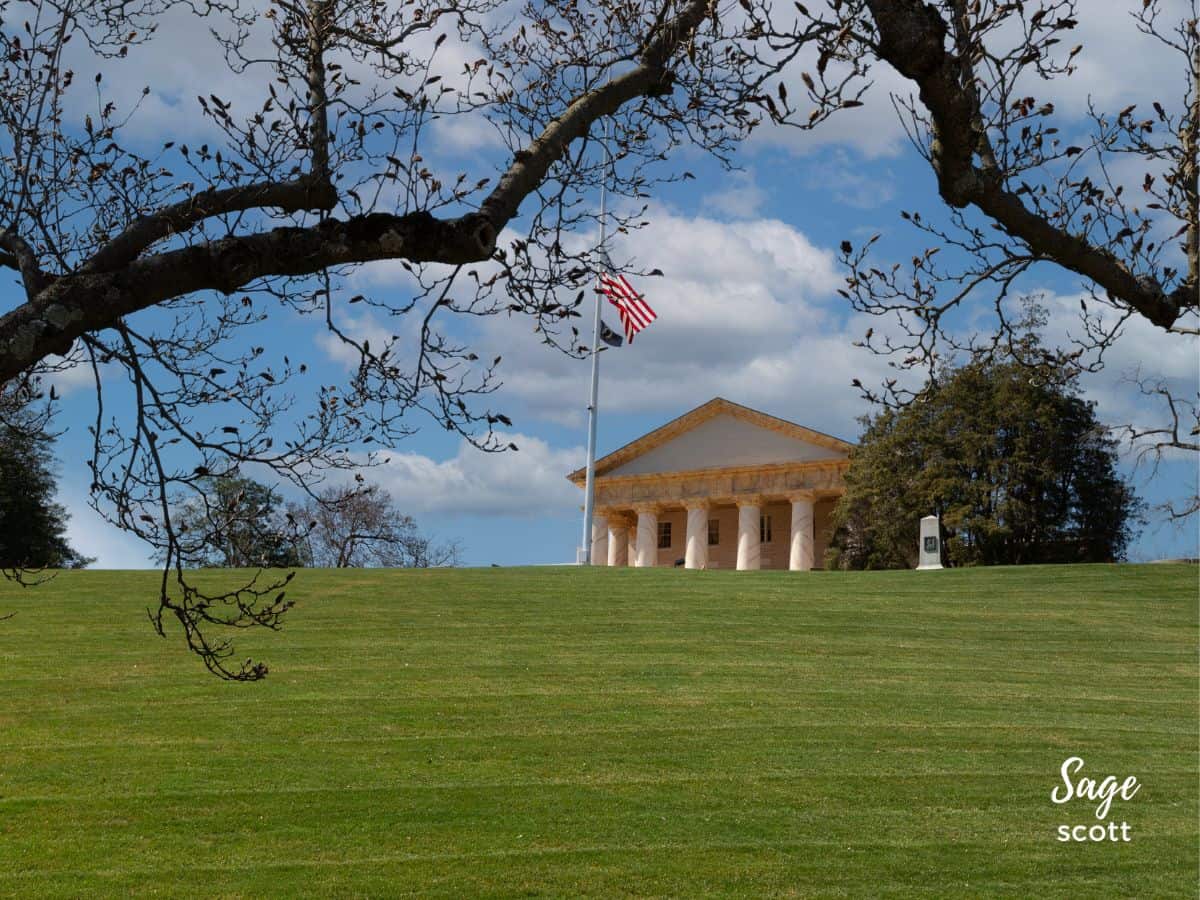
Early History of Arlington House
Before it was Arlington National Cemetery, the wooded land on the west side of the Potomac River was a working plantation. After inheriting the plot from his parents, George Washington Parke Custis (the first president’s step-grandson) was “land rich,” but he did not have a lot of cash to build a home on the acreage.
Custis wanted to build a mansion out of sandstone (the same material used to construct the White House). But without the funds to do so, he directed enslaved African Americans (also part of his inheritance), free blacks, and indentured servants to cover clay bricks with stucco and paint them to look like sandstone.
With eight massive Doric columns and a covered entrance porch, Arlington House is one of the first examples of Greek Revival architecture in the US.
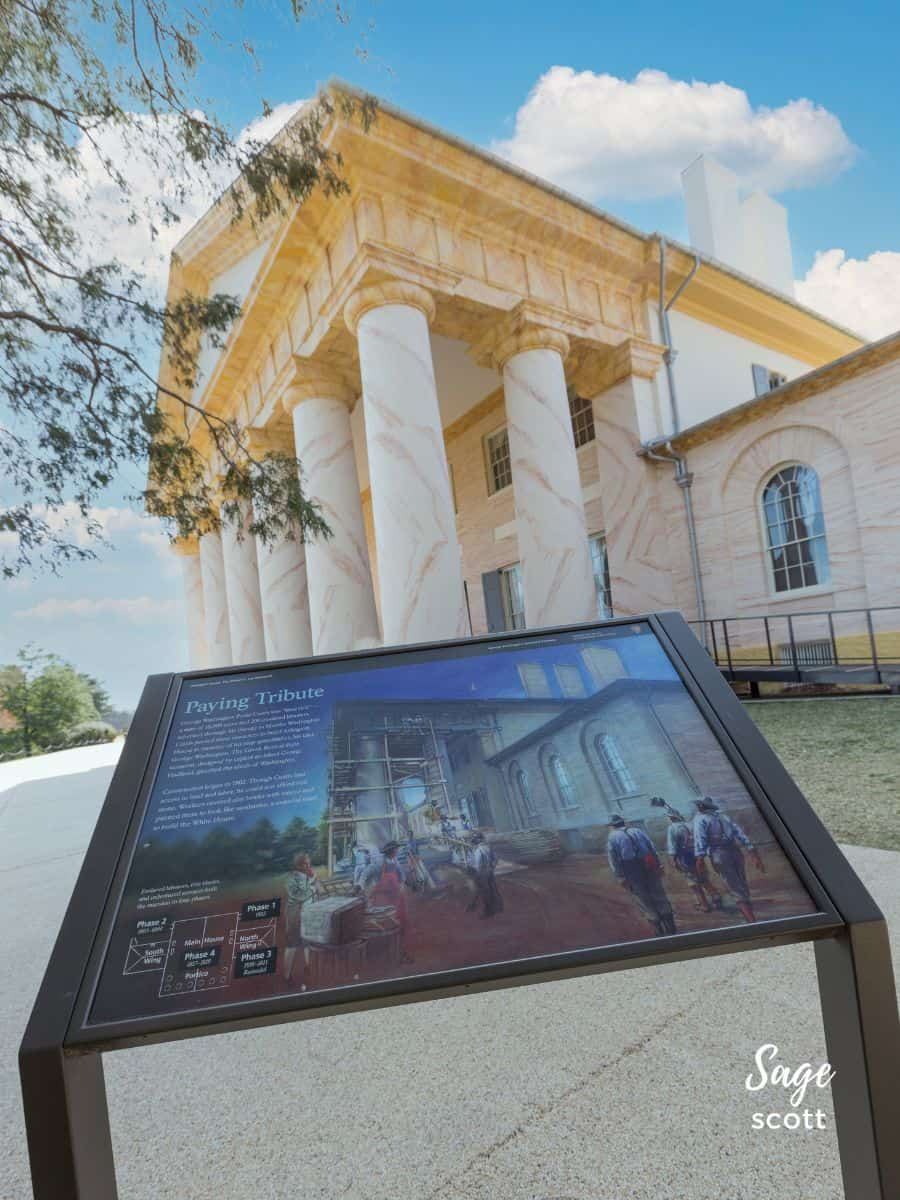
George Washington Parke Custis and his wife, Mary Lee “Molly” Fitzhugh Custis, had one child — a daughter named Mary Anna. Growing up, Robert E. Lee frequently visited Arlington House and knew Mary Anna quite well. Two years after Lee graduated from West Point, he married Mary Anna, and the couple lived in Arlington House for three decades.
When George and Molly died in the mid 1800s, Mary Anna and Robert E. Lee inherited Arlington House.
Sage Advice: Because it is now managed by the National Park Service, you can get your Passport to Your National Parks stamped at the Robert E. Lee Memorial.
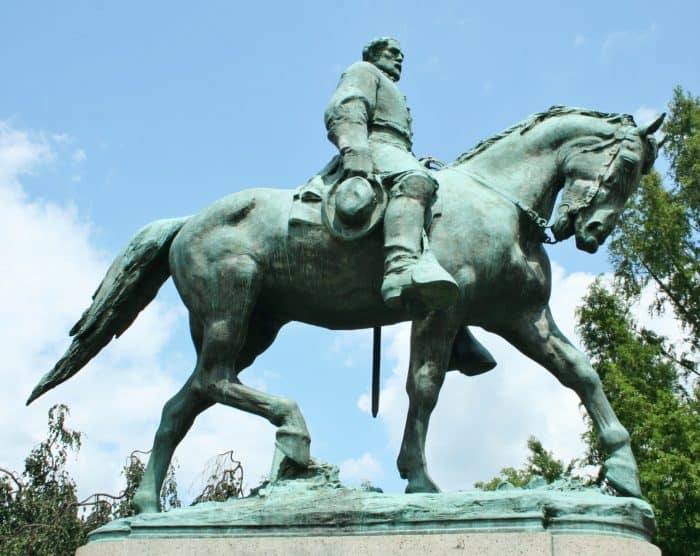
A Bad Breakup
Although he didn’t want to see a divided United States, when Virginia seceded from the United States in April 1861, General Lee aligned with his home state.
“I shall never bear arms against the Union, but it may be necessary for me to carry a musket in the defense of my native state, Virginia, in which case I shall not prove recreant to my duty.”
~ General Robert E. Lee
He resigned his commission in the US Army and joined the Confederate Army. It didn’t take long for America’s leaders — just across the river from a distinguished Army general who had crossed the line — to realize they needed to take control of Arlington House and its prime location overlooking the nation’s capital. Within a few weeks, the Union Army had seized and occupied Arlington House.
Related Article: Best Places to Stay in Washington DC Based on Your Itinerary
Always Pay the Taxman
As the Civil War progressed, the government assessed a new property tax on certain areas that had to be paid in person. In declining health and hunkered down with relatives in the Confederacy, Mary Anna Custis Lee was unable to pay the $92.70 tax (about $1,857 today). So the magnificent Arlington House was seized by the US government for unpaid taxes and auctioned.
The highest bid was for $26,800 (about $431,000 today) offered by (wait for it) the US Government. To further put that bargain into perspective, consider that the median home value in Washington, DC, today is $572,000. What a steal! Literally.
Enjoying This Article?
Sign up for the newsletter!
Thank You for Subscribing!

The Bloodiest War
With more military deaths than World War I, World War II, the Korean War, and the Vietnam War combined, America’s Civil War was the bloodiest in American history. Military cemeteries in Washington, DC, and Alexandria, Virginia, quickly filled with the bodies of young soldiers. Army General Meigs proposed that 200 acres of the Arlington estate be converted into a cemetery, and US Secretary of War Stanton created Arlington National Cemetery in June 1864.
A fellow graduate of West Point, Meigs felt that General Lee had committed treason by leaving the Union to command the Confederate Army, fighting directly against those with whom he once served. And Meigs was determined to get revenge. In order to ensure that Lee’s beautiful home would be rendered unlivable, the first Union Army soldiers were laid to rest in the main flower garden close to the house.
Fun Fact: At the same desk Robert E. Lee sat at to pen his resignation letter from the Confederate Army, President Gerald Ford signed a bill in August 1975 reinstating Lee’s US citizenship.
You Can Never Go Home Again
In the five years between the end of the Civil War and his death, Robert E. Lee made no attempt to visit Arlington House. But a few years later, just months before her death, Mrs. Lee returned to Arlington House. She was so upset by the condition of her family home that she refused to go inside and left quickly. The following year, after the death of both of his parents, General and Mrs. Lee’s oldest son, George Washington Custis Lee, attempted to regain his family’s property by suing the US government.
When the Supreme Court ruled that Arlington House had been illegally confiscated, it ordered that the property be returned to the younger Lee. However, it quickly became clear that he was less interested in having his family’s property returned and more interested in a cash settlement. It was ultimately decided that the US Government would pay Lee $150,000 (about $3.75 million today) and retain ownership of the historic mansion.
A Community for Freed Slaves
Meanwhile, as slaves were freed during the Civil War via President Lincoln’s Emancipation Proclamation, Freedman’s Village was established on the Arlington property. With housing, schools, and a hospital, the community was designed to help newly freed slaves transition to freedom. Like many historic structures in the nation’s capital, Robert E. Lee’s house was built and maintained by a community of enslaved workers. So it’s easy to understand why abolitionists were excited to establish Freedman’s Village on the Confederate Army leader’s property.
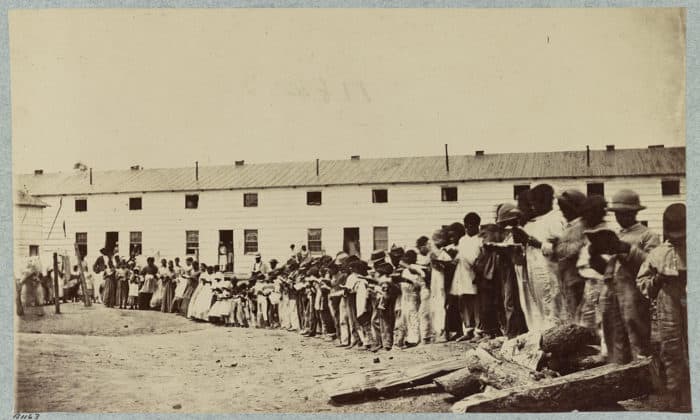
But like the Chinatowns in San Francisco and New York when they were established more than a decade earlier, Freedman’s Village was more about segregation than helping former slaves integrate into a free society. In a community run by military discipline, thousands of freed men, women, and children tried to adapt to a new life away from slavery.
Unfortunately, life in Freedman’s Village was only slightly better than life as a slave on a southern plantation. Able-bodied members were put to work on construction projects and tending fields. While they received a monthly salary of $10 (about $200 today), they were required to pay half to a general fund used to maintain the village.
Fun Fact: Born into slavery in New York, Sojourner Truth escaped to freedom with her infant daughter and successfully sued a white slave owner to gain custody of her son. Deemed one of the “100 Most Significant Americans of All Time” by Smithsonian magazine in 2014, Truth lived in Freedman’s Village for a year in 1864.
Although the village had fifty 1-½ story homes, each house was divided to accommodate two families. Built on swamp lands, Freedman’s Village had only one source of water, a single well that was tied to several smallpox outbreaks. After toiling in the fields, gardens, and orchards, the fruits of their agriculture labor were sold to consumers in Washington, DC, while the freed slaves were forced to subsist on military rations. The harsh conditions caused tensions to rise between residents and the federal government. And in 1900, the people living in Freedman’s Village were evicted to make room for more military graves.
Sage Advice: If you plan to explore the Smithsonian museums when you visit Washington, DC, check out this complete guide to the Smithsonian museums on the National Mall.
Modern-Day Mansion Managed by the National Park Service
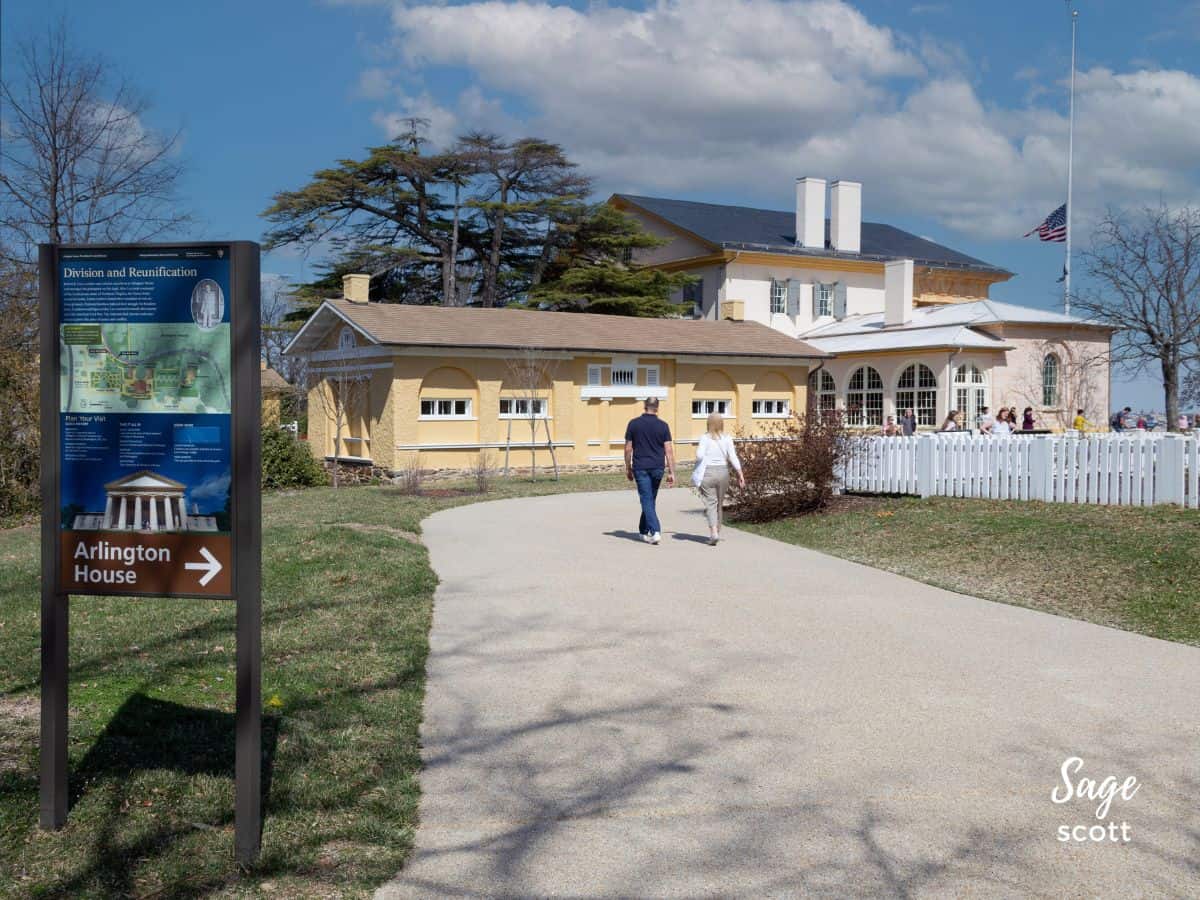
Still in the hands of the federal government, Arlington House remained neglected and in a state of disrepair until Congress passed a resolution in 1925 to restore the home. However, it was refurbished to reflect George Washington’s time period, intentionally erasing Robert E. Lee from the mansion’s history.
But 50 years later Congress enacted a new law that designated Arlington House as the Robert E. Lee Memorial. The home and the grounds that immediately surround it are managed by the National Park Service. Over half of the original 1,100-acre plantation is managed by the US Department of the Army as Arlington National Cemetery, the nation’s best known military cemetery.
Related Article: 12 Graves to Visit in Arlington National Cemetery (After You’ve Paid Respect to JFK)

Visiting the Robert E. Lee Home in Washington, DC
A $12.5 million restoration project was recently completed, and the Arlington House is now open daily. There is no admission fee to tour Robert E. Lee’s former home, and no tickets are required to visit.
To visit Arlington House, enter via the main Arlington Cemetery entrance. The mansion is located at the top of a hill above President Kennedy’s grave. It’s a bit of a hike, so I recommend purchasing a tram ticket.
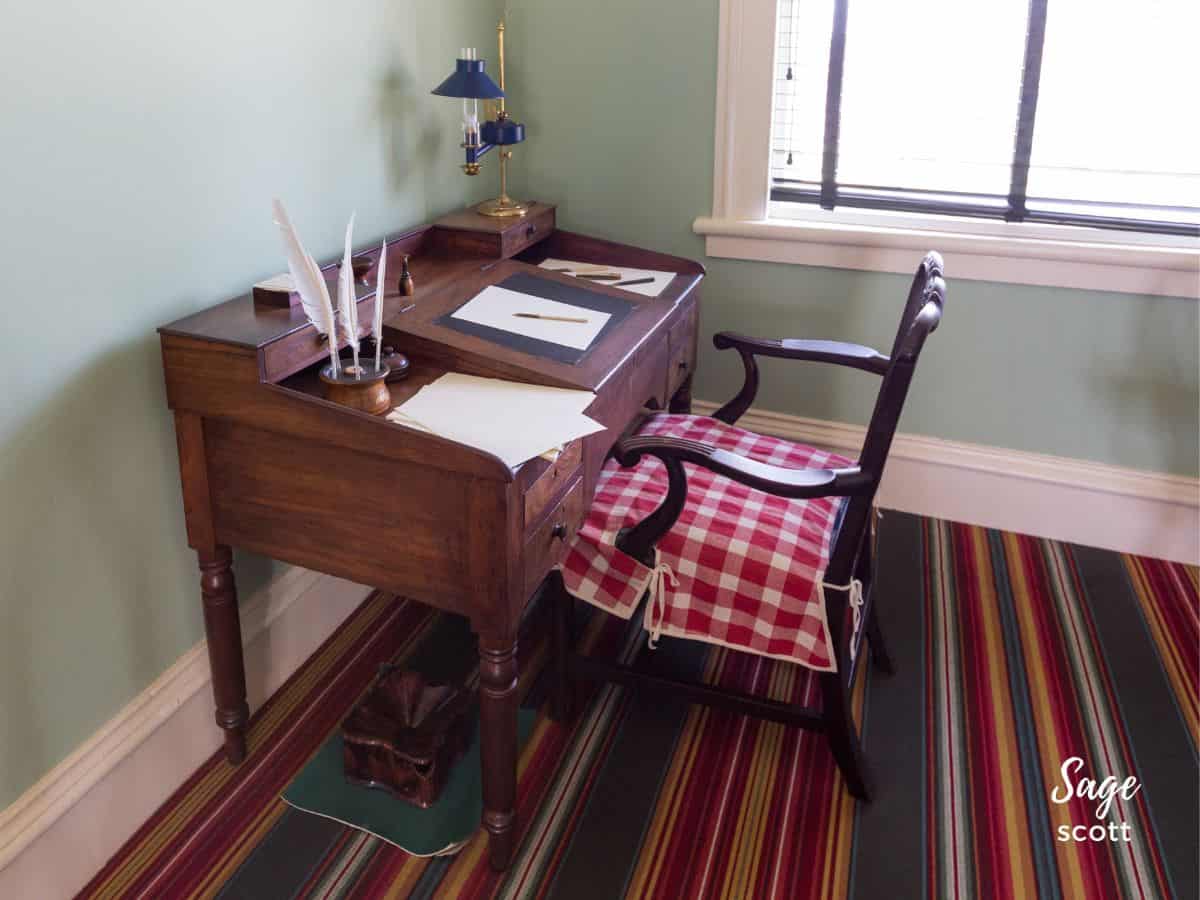
Allow about 20 minutes to take a self-guided tour of the mansion. Don’t miss Robert E. Lee’s desk, for it was at this desk that President Gerald Ford officially pardoned General Lee for fighting for the Confederacy in 1975.
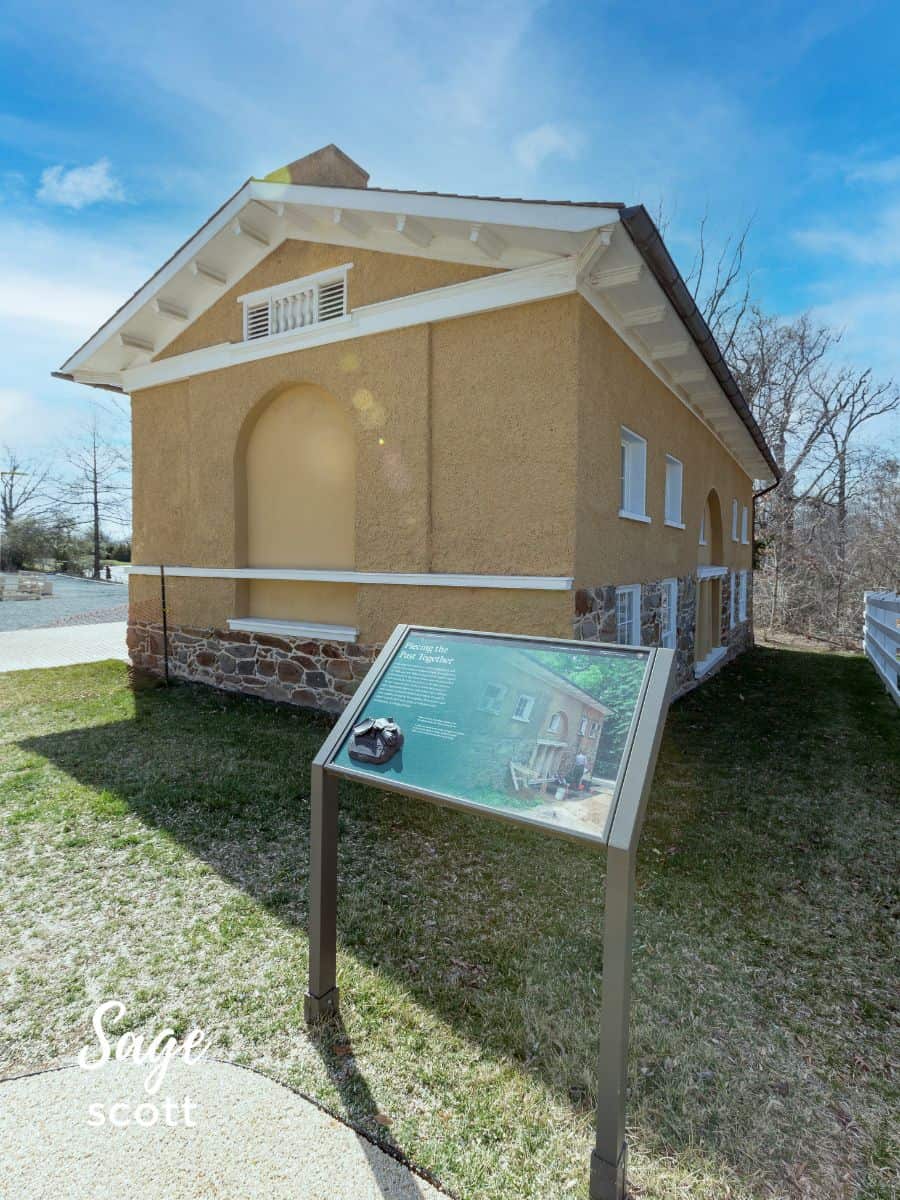
Then explore the grounds, stopping at the museum and slave quarters. The Museum at Arlington House contains exhibits and artifacts about General Lee and his family. The two slave quarters — located on the north and south ends of the grounds — help tell the story of the enslaved people who lived at Arlington House.
Sage Advice: Here’s everything you need to know BEFORE you visit Arlington National Cemetery.
Frequently Asked Questions About Arlington House
What is Arlington House?
Originally known as the Custis-Lee Mansion, Arlington House is a Greek Revival style mansion that sits high on a hill overlooking the Potomac River and National Mall. It is surrounded by what is now Arlington Cemetery.
Is Arlington House open?
After completing a $12.5 million restoration project, the National Park Service reopened Arlington House (also known as the Robert E. Lee Memorial) in June 2021. The house is open daily from 9:00 am to 4:30 pm. (The last tour is at 4:00 pm.)
Who built the Arlington House?
George Washington Parke Custis (President Washington’s step-grandson) built a mansion on inhereted land overlooking the nation’s capital.
Who lived in the Arlington House?
When Custis and his wife died, the house was passed down to their daughter, Mary Anna Randolph Custis. Married to General Robert E. Lee, Mary Anna’s childhood was once known as the Custis-Lee Mansion.
Have You Visited the Arlington House at Arlington National Cemetery in Washington, DC?
What did you do and see when you visited? Any tips or tricks to pass along? Share your experiences in the comments section below.
Looking for more information to plan your Washington DC vacation? Check out my additional recommendations to help you plan your trip to Washington, DC, including what to see and do in Washington DC, the best places to stay in Washington DC, where to eat in Washington DC, and more!
Ready to Go?
Use These Helpful Links to Book Your Trip!
- Find low fares with airfarewatchdog and Skyscanner
- Book your plane ticket with Expedia or Kayak
- Or take the scenic route on an epic road trip in a rental car or an RV from Outdoorsy
- From hotels to private homes, find the perfect accommodation with Hotels.com or Vrbo
- Travel in style with a suitcase, carry-on, backpack, or handbag from eBags
- Save on tickets to attractions, sightseeing tours, and more with CityPASS, Tiqets, and Viator
- Don’t leave home without travel insurance from AXA
- Discover the sights, history, and culture of your destination with an interactive scavenger hunt
- Need something else to plan your perfect trip? Visit my travel resources page for more trusted partners. Happy wandering!
More Articles You'll Love!

Everything You Need to Know BEFORE You Visit Arlington National Cemetery.

Explore via an Interactive Scavenger Hunt. Seven reasons you should take a scavenger hunt today!
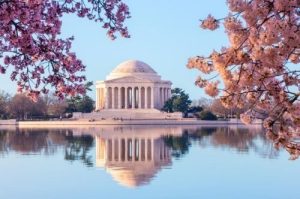
Best Places to Stay in Washington, DC. Identify the best DC neighborhood based on your itinerary.
Thank you for sharing!

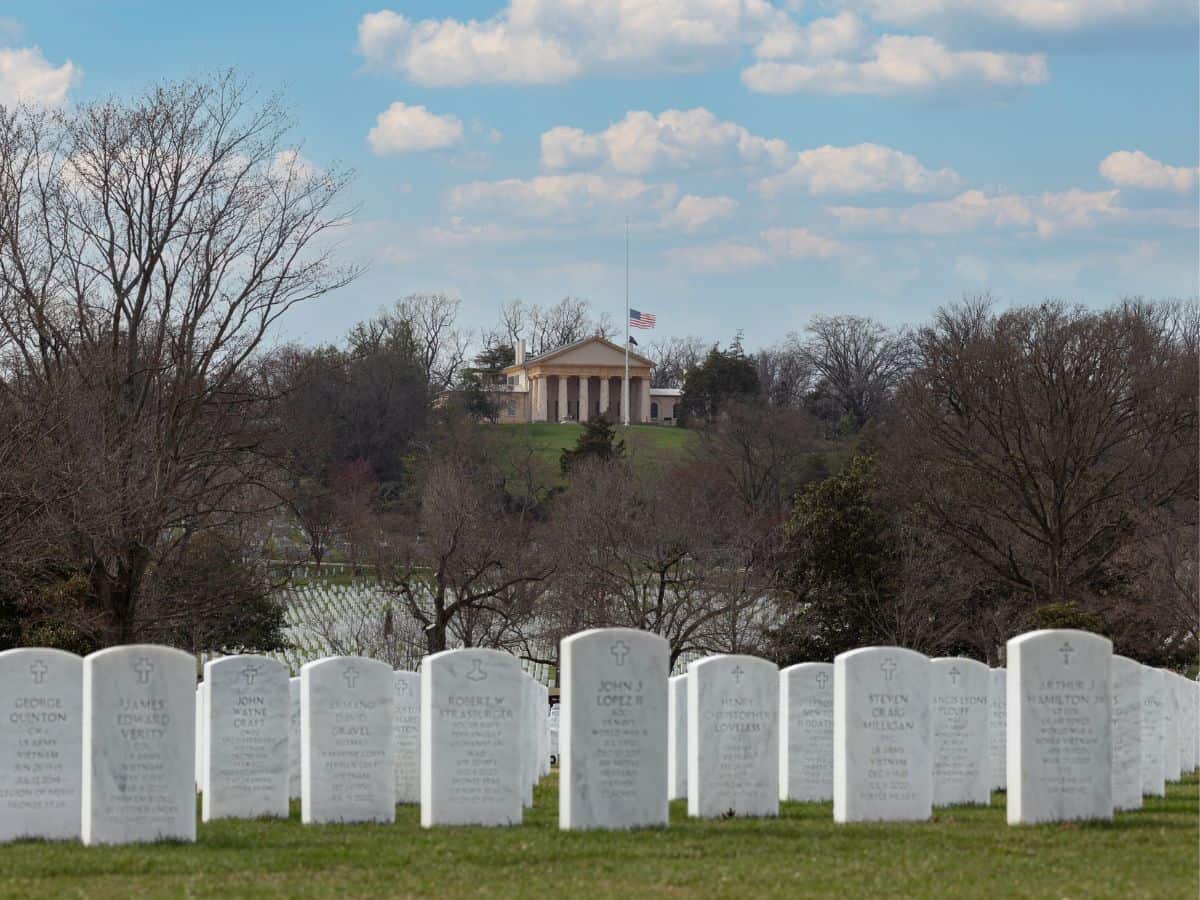

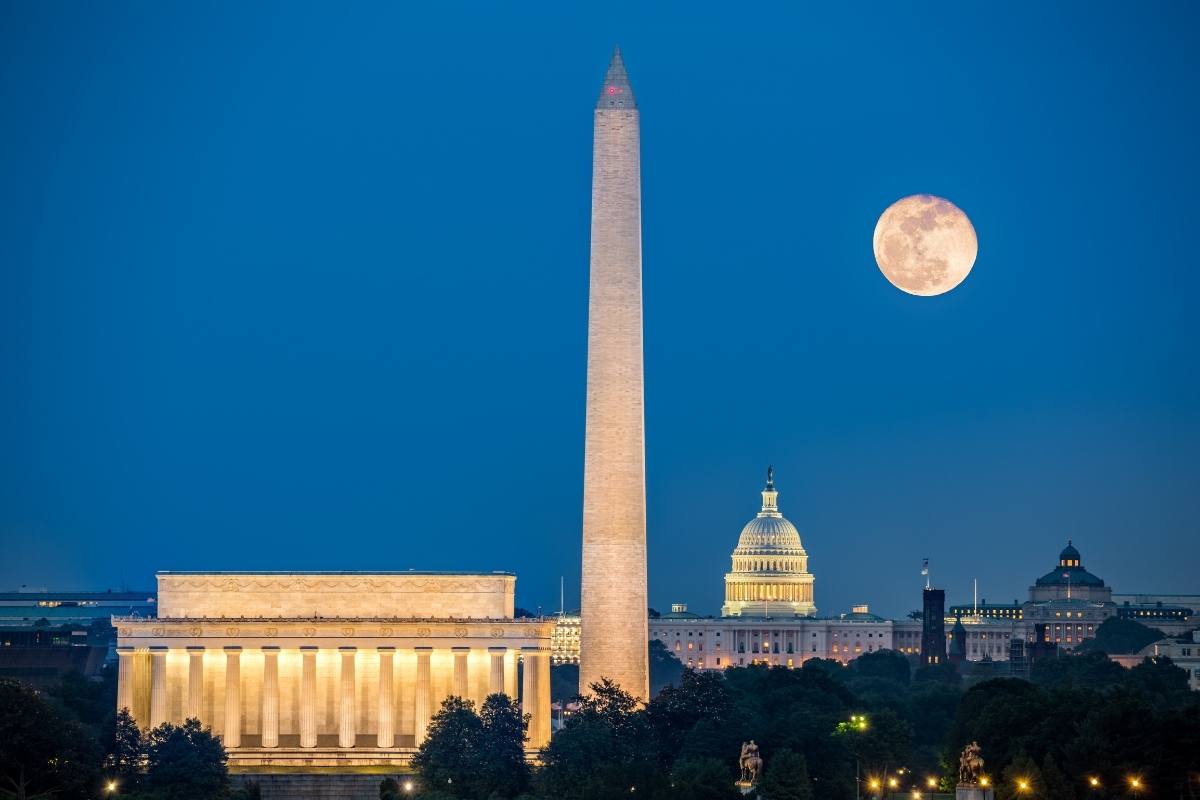

As a little girl about 2 my folks visited Washington DC and they took a picture of me saluting on the Capital’s steps. I remember when President Kennedy was killed and how shocked the world was. Then Robert. I don’t know why the Kennedy family has had to pay such a high price.
Cindy Thornlow
Palmer, Alaska
Hi Cynthia! Thanks for stopping by and sharing your experience in DC!
What a fascinating history. I confess I know fairly little about the period after the civil war. It sounds like it was not great for those freed 🙁
Yes, former slaves definitely had to work so hard to achieve equal opportunities in terms of education, housing, employment, and more once freed. It is such an important thing for us to remember and learn from in history.
Wow! I feel like you just gave me an awesome history lesson. I’ve visited Arlington Cemetery several times but had no idea the history behind the house.
I feel like this part of American history would make a really great episode of Drunk History!
This was such a fascinating post! Would love to visit this place one day. So much history 🙂
Wow! I’ve been to Arlington Cemetery a few times and had NO IDEA how in depth the history of Arlington House went! I’d love to revisit when the Arlington House renovation is finished next year! Thank you for such an informative post!
I know! That’s why we travel, right? And it’s easy to miss all of this fascinating history when simply taking the tram to the highlights like the Kennedy grave sites and Tomb of the Unknowns.
Interesting. We visited Washington for the first time a couple of months ago and learned so much, but barely scratched the surface. Did not make it to Arlington, but will definitely go next time we visit. So much history! We did, however, make it to Monticello, Thomas Jefferson’s home, a little later. We were quite taken aback at what we discovered there!
Even after living in the DC area three different times growing up, I joked with my mom and my daughters about our visit last spring. “Okay, if we don’t eat or sleep and go hard at DC 24 hours a day we *might* get to our “A” list of things to do and see!” There is sooooooo much to do and see! And about TJ, um, yeah. The Founding Father is so revered in the version of history taught in school, but the fact remains that he owned more slaves that all of the other slave-owning presidents combined. I think that’s why I so enjoy looking up at the MLK memorial and following his gaze across the water to the Jefferson Memorial.